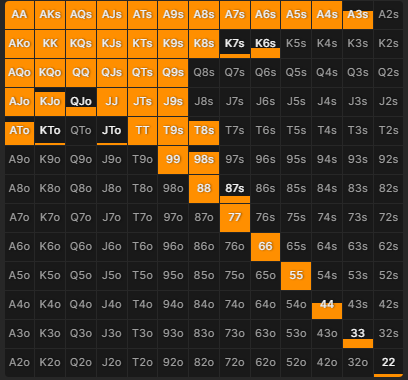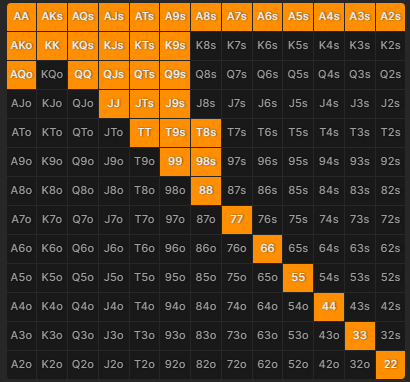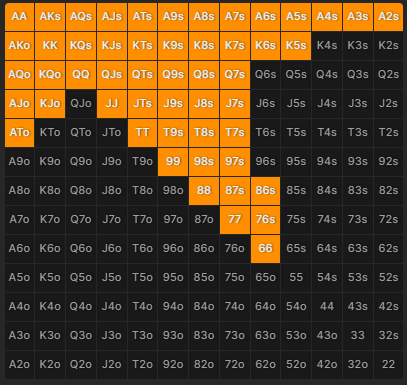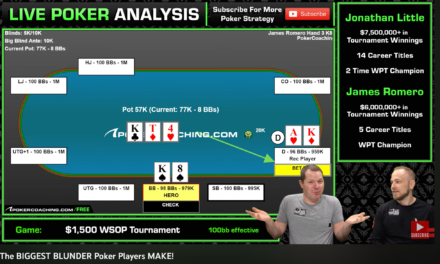
In our previous article, we discussed how to adjust to a singular player based on opponent-specific information we gathered at showdown. Now, I want to talk a little about how to exploitatively adjust to specific table dynamics in general and an easy framework for you to use to put yourself in the right mindset to adjust your preflop ranges to best adapt to a specific table.
A simple way to identify table tendencies is to start by asking yourself two questions:
- How many players, on average, are seeing the flop?
- How many hands, on average, are going to showdown?
Table Looseness:
The question of how many players see the flop speaks directly to “table looseness.” There is a direct correlation between the number of players seeing the flop and the average winning hand strength at showdown.
If four or more players regularly see the flop, you want to exploitatively adjust your preflop range to give yourself more opportunities to make sets, strong/nut flushes, and strong/nut straights. Some of the biggest pots are won when you have stronger draws than your opponents or when you flop a set when your opponent flops top pair and can’t find their fold button.
Showdown:
The question of how many hands go to showdown speaks directly to continuation betting (which we will discuss in great detail later).
If most hands are going to showdown, then continuation betting is going to be something you only want to do with significant equity in the hand.
If most hands are not going to showdown, then you want the ability to not just be able to continuation bet frequently but also select hands that have the ability to frequently fire again on the turn and river as well.
Most commonly, this is done with hands that flop backdoor equity (for example, if you have two clubs, then one club on the flop gives you a “backdoor” club draw as you can hit running clubs to make a flush) so that you can frequently fire on the turn when you turn additional equity in addition to the times the turn is a card that is significantly better for your range than your opponents.
So, the more players that are regularly seeing the flop, the more you will want to exploitatively include hands like pocket pairs, suited aces, suited broadway cards, and some of the bigger suited connectors and suited kings in your range. You’ll also want to reduce how many offsuit big cards you have in your range.
Let’s look at an example. First, below, is the default, early position first-in raising chart for a GTO table at 50 BB effective stacks:

Loose Tables:
Next, in the chart below, we see it exploitatively adjusted for a loose table with multiple players seeing the flop and many hands going to showdown. Note that more pairs (actually all pairs) and big-suited hands are being played while fewer offsuit big cards make the cut.

Tighter Tables:
Now, let’s look at how things change when the table is tighter (see chart below). When fewer players see the flop, the smaller pairs and some of the suited connectors significantly decrease in value.
Big, offsuit cards increase in value (compared to a loose table) as top pair more frequently wins at showdown, and having your opponent “outkicked” can be a large source of profit.

Notice, in the chart above, how it consists of more big card hands and suited hands capable of firing more barrels and fewer pairs since your implied odds (definition below) are lower, and those hands are troublesome to fire multiple barrels with. If you wanted to be closer to GTO and have better board coverage, you could mix 22-66 at a smaller frequency. One way to do this in real-time is to tell yourself you’ll only play the “red” (or “black” but not both) combo of each pair, so you’re playing them all exactly ⅙ of the time.
Hand frequency going to showdown often directly correlates with your implied odds as your opponents become “stickier” across multiple streets; hands with greater implied odds (pocket pairs, big suited cards) increase in value. When opponents are less sticky, many of the suited and connected cards can retain their value as good semi-bluffing candidates across multiple streets. Still, your weaker pocket pairs and offsuit cards become more problematic.
Exit Points:
You could take this one step further and pay attention to the most common exit points postflop. If most players are playing extremely “fit or fold” (i.e., when they hit the flop, they continue, and when they don’t, they fold), you would use slightly different ranges than if most hands are ending on the turn and river, with opponents only giving up once the bet sizes start to increase.
These two questions work in tandem as well. The hand range you’ll exploitatively want to open with at a loose table where many players are seeing the flop and many hands are going to showdown will be slightly different than a tight table when many players are seeing the flop, and few are going to showdown. The smaller pocket pairs will start to disappear from your range as the implied odds those hands receive when they flop sets becomes worse, while you’ll be able to expand some of your bigger suited cards out a little bit for more semi-bluffing opportunities
Are You Paying Attention?

It is important to note that when you ask yourselves these questions, the answers should be somewhat obvious if you’re paying attention. If you’re not sure if there are a lot of players seeing flops or not or if a lot of hands are going to showdown, it is likely not a table where there is an outlier, so you should just stick with your solid, GTO-based, first-in hand ranges.
You will also have to constantly reevaluate these questions as the blinds increase and players are eliminated and replaced by new ones. If you’re going to make exploitative changes, it is important to consistently be engaged and pay attention to the table dynamics around you.
Winning in poker is often built around putting yourself in the best possible situations from the very beginning of the hand. By paying attention and asking yourself a few simple questions while you’re playing, you can make slight alterations to your preflop ranges to set yourself up for success.
We will do a deep dive on 3-betting and 4-betting next, as those can also significantly impact your preflop ranges!
Remember, in the world of poker, exploiting your opponents is not just okay; it’s your ace in the hole.
Until the next deal,
Eric “Rizen” Lynch
To see Rizen PXF videos, go to the PXF Training Center. Eric is an instructor at LearnWPT where he answers questions in their Ask a Pro service, runs live workshops, and hosts live seminars!
To be alerted to future editions to this series, sign up for the free PXF Newletter!
Definitions in this article:
Implied Odds:
Implied odds in poker refer to the concept of calculating the expected amount of money that you can win on future betting rounds, in addition to what is already in the pot. This calculation is made when you are drawing to a hand (meaning you need one or more specific cards to come to make your hand a winning one). Implied odds are a more advanced and speculative measure than pot odds because they require you to estimate how much more you might win from your opponents in the remaining rounds of betting, should you complete your drawing hand.
Fit or Fold:
“Fit or Fold” describes a poker strategy where a player proceeds only if they connect well with the flop (fit) or exits the hand if they don’t (fold). This passive approach focuses on playing strong hands and folding to aggression without much creative play, making it predictable and exploitable by aggressive opponents. While it can succeed in passive games, it’s less effective against skilled players who might bluff more, expecting folds from those not hitting the flop hard.






